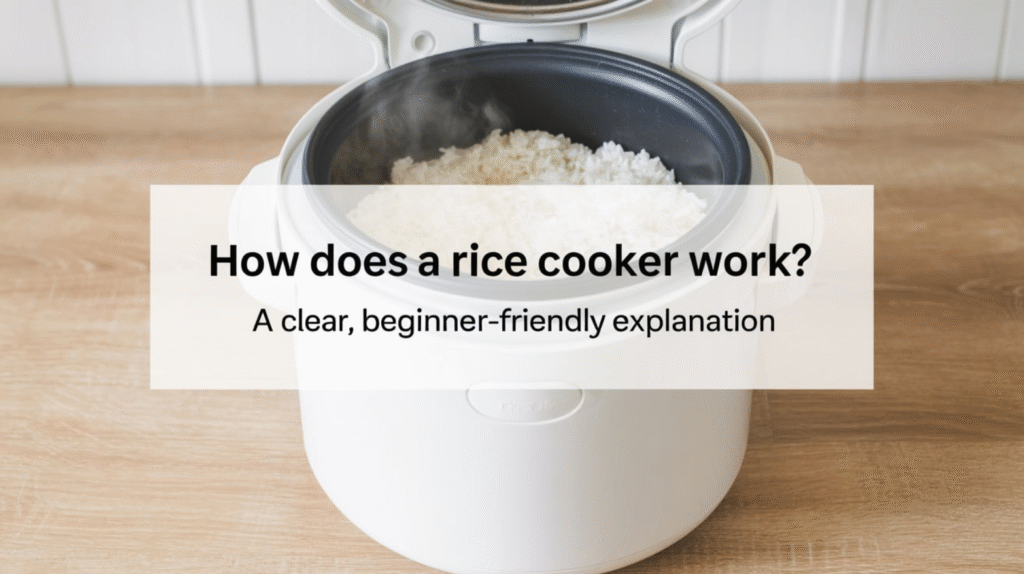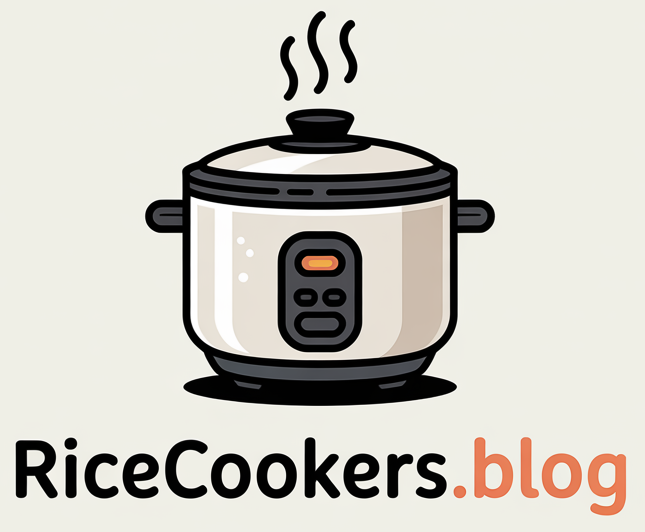A rice cooker works by heating water, absorbing it into the grains, and using temperature changes to switch automatically from cooking to warming. It follows a controlled cycle that ensures the rice cooks evenly without burning. This matters because it removes all guesswork, allowing you to prepare perfectly cooked rice with almost no effort, whether you’re a beginner or an experienced home cook.

Understanding how this appliance works also helps you choose the right model, use it correctly, and get consistently fluffy results every time.
The Basic Mechanism Behind Every Rice Cooker
A rice cooker uses a simple but precise method to turn uncooked grains and water into soft, fluffy rice. The combination of a heating element, a metal pot, and automatic sensors ensures predictable results.
The Inner Pot and Heating Element
The inner pot sits directly on top of a heating plate located at the base of the cooker. This plate transfers heat to the pot, which in turn heats the water and rice inside it.
How Heat and Water Create Steam
As the pot warms up, the water begins to boil. The boiling activity generates steam, which gradually softens the grains. This step is crucial because:
- The boiling phase allows the rice to absorb water at a controlled pace.
- The steam softens the grains from the inside out.
Temperature Change Signals the Cooker to Switch Modes
A rice cooker relies on the boiling temperature of water — 100°C — as a reference point. When all the water has been absorbed or evaporated, the temperature inside the pot rises above 100°C.
This matters because:
- The cooker recognises the temperature rise as the sign that cooking is complete.
- It automatically switches to “keep warm” to prevent burning.
Why Rice Cookers Cook Rice So Consistently
Rice cookers maintain stable heat and follow a reliable cycle from boiling to steaming to resting. Every grain cooks at the same rate, resulting in a uniform texture.
Even Temperature Distribution
Because the pot is surrounded by heat, the rice cooks evenly.
This helps because:
- You avoid undercooked or hard grains.
- You prevent mushy pockets caused by uneven boiling.
The Resting Phase Improves Texture
Once the cooker switches to “keep warm”, the rice continues to steam gently.
This final step is important for two reasons:
- It allows excess moisture to settle evenly.
- It makes each grain firmer, fluffier, and easier to serve.
The Water-to-Rice Ratio Plays a Key Role
A rice cooker can only work properly if you add the right amount of water. Too little water leads to dry, undercooked rice, while too much causes mushiness.
How the Ratio Affects the Cooking Cycle
The water ratio controls how long the boiling phase lasts.
For example:
- More water means a longer cooking time.
- Less water shortens the cycle.
Cooker Markings Make Measurements Easy
Most inner pots include water level lines.
These markings are helpful because:
- They adjust automatically for different rice quantities.
- They ensure consistent results without manual measuring.
Different Types of Rice Cookers Work Slightly Differently
Although all rice cookers follow the same basic principles, advanced models use smarter technology to adapt cooking time and temperature.
Basic On/Off Rice Cookers
These simple models use the traditional temperature-based switch.
They are ideal because:
- They are affordable and reliable.
- They cook standard white rice easily.
Micom (Microcomputer) Rice Cookers
Micom cookers include a microchip that adjusts heat and timing throughout the cycle.
This brings benefits such as:
- Better control over texture and moisture.
- Compatibility with different rice types like brown, jasmine, and mixed grains.
Induction Heating Rice Cookers
Induction cookers heat the entire pot using magnetic currents instead of a single plate.
They offer advantages including:
- Faster heat adjustments.
- More precise cooking, especially for premium rice varieties.
How the “Keep Warm” Function Works
Once the rice is cooked, the cooker keeps it warm without overcooking it. This function gently maintains temperature while preventing further boiling.
Low, Steady Heat Protects Texture
The cooker doesn’t return to high heat; it simply keeps the temperature stable.
This helps because:
- The rice stays fluffy for hours.
- It prevents drying or burning at the bottom.
Ideal for Batch Cooking
The keep-warm mode is especially useful for busy households.
You can:
- Prepare rice ahead of time.
- Serve at different times without reheating.
Extra Features That Support the Cooking Process
Modern rice cookers include design features that enhance the appliance’s performance and ease of use.
Steam Vents and Lids
These prevent excessive pressure build-up.
They help because:
- They allow steam to escape safely.
- They maintain moisture without causing overflow.
Non-Stick Inner Pots
These make both cooking and cleaning easier.
Important points include:
- Less rice sticking to the bottom.
- Faster, more convenient clean-up.
Why Understanding the Process Improves Your Cooking
Knowing how a rice cooker works helps you use it more effectively. When you understand the cycle, you can adjust recipes, grains, and water levels to achieve perfect results every time.
Better Control Over Texture
Small adjustments to water or soaking time become easier once you know how the cooker responds.
Examples include:
- Adding a little extra water for softer rice.
- Reducing water slightly for firmer grains.
More Confidence with Different Rice Types
Each variety absorbs water differently, and understanding the cooker’s mechanism allows you to adapt effortlessly.
FAQs
Here are some questions and answers about how a rice cooker works:
Why does a rice cooker stop cooking automatically?
It stops because the temperature rises above 100°C once all the water has been absorbed. This signals the cooker that the rice is done, prompting it to switch to “keep warm”.
Can a rice cooker overcook rice?
It rarely happens unless the water ratio is incorrect. The automatic switch prevents continued boiling, so rice generally stays moist and fluffy.
Does a rice cooker need constant monitoring?
No, the cooker handles the entire process automatically. You only need to measure the rice and water correctly before starting.
Why does rice sometimes stick to the bottom?
Sticking can occur if the pot isn’t properly cleaned, the non-stick coating is worn, or the water level is too low. Using the correct ratio helps prevent this.
Can all rice types be cooked using the same method?
Most rice types follow the same basic process, but some need slightly different water ratios. Advanced cookers adjust automatically for different grains.
